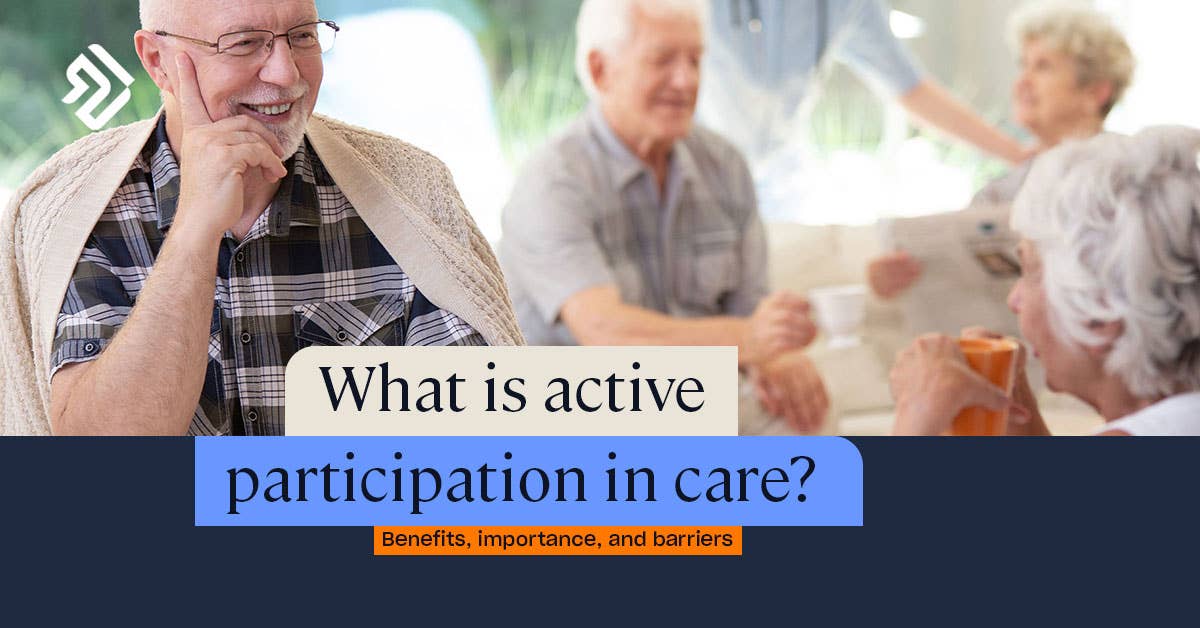Individuals family an individuals family may believe that their loved one should not be doing things for themselves. 43 Demonstrate ways to reduce the barriers and encourage active participation There are several ways that these barriers can be reduced and active participation encouraged.

Active Participation In Care Benefits Importance Barriers
Identify possible barriers to active participation and then describe ways of reducing barriers to active participation.

. An individual being non-verbal. Chronic pain sadness insecurity depression loss of hearing poor eye sight memory loss immobility. DESCRIBE WAYS OF REDUCING BARRIERS TO ACTIVE PARTICIPATION.
Active participation can be used to support all aspects of an individuals preferences and needs because the individual will have a big say in how their care and support is provided. Attitudinal barriers are the most basic and contribute to other barriers. Hi active participation is person-centred as it treats the person as an individual it is about recognising an individuals right to participate in the activities and relationships of everyday life as independently as possible.
Lack of staff training Staff may not have had sufficient training to ensure they understand the importance of active participation and ways in which they can support it. Enable people to maintain the maximum possible level of independence choice and control. The individuals care.
Lack of interest by the individual individuals that have received passive care over the long-term may be used to others making decisions on their behalf and doing things for them. Active participation allows the individual more control. Treat each person as an individual by offering a personalised service.
Equality and diversity can help reduce barriers to activeparticipation and help everyone feel important. Access transport distance physical barriers etc facilities location access ramps safety lights etc affordability cost of participation fees memberships equipment etc awareness how to get involved. Explain what steps to take if consent cannot be readily established.
Also by increasing staff training and awareness of possible communication barriers such as the use of makaton and sign language would certainly reduce communication barriers whereby verbal communication is a barrier. Factors including the following can cause barriers to active participation. Equality and diversity can help reduce barriers to active participation and help everyone feel important.
The individual is an active partner in their own care or support rather than being passive. Support people with the same respect you would want for yourself or a member of your family. The individual is an active partner in their own care or support rather than a passive recipient.
Active participation is a way of working that supports an individuals right to participate in the activities and relationships of everyday life as independently as possible. Offer praise compliments encouragement and constructive feedback. AĐtiǀe paƌtiĐipatioŶ ƌeĐogŶises aŶ iŶdiǀiduals ƌight to paƌtiĐipate iŶ the aĐtiǀities aŶd ƌelatioŶships of everyday life as independently as possible.
Some examples of barriers to active participation include. 41 Describe different ways of applying active participation to meet individuals needs Active participation is defined as recognising an individuals right to participate in the activities and relationships of everyday life as independently as possible allowing individuals to be an active partner in their own care or support rather than a passive recipient. Make sure theclients are comfortable in the environment.
By promoting and encouraging the individual to active participation can give positive outcomes. The unit also examines. Issues concerning informed choices are considered together with the balance of risk-taking and assessing when empowering individuals to exercise their rights to choice.
Make sure the clients are comfortable in the environment. Ways of reducing barriers to active participation. 43 Describe ways of reducing barriers to active participation.
Describe how active participation benefits and individual Define the term consent. Listen and support people to express their needs and wants. Physical modifications could be made to the building to make it more accessible or a different building could be used.
When an individual is encouraged to take an active role in planning their support they are better able to live the life that they choose in the way that they want. 7 rows How to reduce. First and foremost it is important that staff have received the proper training and have the correct attitudes and behaviours.
Individuals health work with the individual to support them to understand their rights and the benefits of active participation and encourage them to do so. For example some people may not be aware that difficulties in getting to or into a place can limit a person with a disability from participating in everyday life and common daily activities. Of active participation the benefits of this and also ways of reducing barriers to enable full participation by all users of the service.
Add answer 5 pts. Describe how to establish consent for an activity or action. The individual is the expert who knows best the way of life that matters to.
The individual is regarded as an active partner in their own care or support rather than a passive recipient. Communication and sensory impairments Being able to communicate effectively with the care worker or within social settings may make participating or expressing themselves more. At times there are barriers to overcome but by enhancing building confidence giving praise and compliments encourage and being aware of communication barriers use of makaton and sign language can help can gie.
There are a number of well documented barriers which may prevent people from accessing sport and active recreation opportunities in their communities. Describe ways of encouraging active participation. There are many ways of reducing barriers to active participation organising and providing opportunitys for involvement in social activities Treating all individuals equally whilst still recognizing that everyone has differences and everyone is unique A main way of reducing barriers is to introduce different ways of communication such as Makaton Sign language.

Encouraging Active Participation Benefits Barriers How To Encourage

Encouraging Active Participation Benefits Barriers How To Encourage

Encouraging Active Participation Benefits Barriers How To Encourage
0 Comments